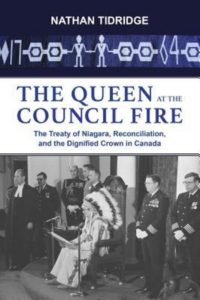Book Review: The Queen and the Council Fire: The Treaty of Niagara, Reconciliation, and the Dignified Crown in Canada
 Reviewed by Karl Hele
Reviewed by Karl HeleBeginning as an essay exploring the importance of the 1764 Treaty of Niagara where more than 2,000 First Nations and representatives of the British Crown created a relational framework, Tidridge’s book offers a settler’s narrative of a personal journey through history, constitutionalism, and Settler-Indigenous relations, as well as a discussion of the divergent views and expectations of the Crown in Canada. The focus of Tidridge’s efforts is to engage his readers in a journey of reconciliation between Canadian and Indigenous peoples rather than a historic recount of 1764.
Tidridge explains the difference between the ‘dignified’ and ‘efficient’ Crown concepts which are key concepts to some of the misunderstandings in Canada since at least 1764. First Nations, he notes, generally see the Crown as “efficient”, meaning the Monarch is supposed to be actively involved in protecting Indigenous rights and treaties. Additionally, based on presentations by the Crown’s agents and our own sense of sovereignty, First Nations saw a direct relationship formed with the Monarch as defined by Indigenous understandings of family relationships which differed from the patriarchal ideas of family among English settlers. These historic interactions and cultural interpretations led First Nations to understand that the English Crown must play a direct role in ensuring our rights and treaties are respected, protected, and enforced.
In comparison to the First Nations interpretation of the Crown, Tidridge discusses the Monarch’s role under the Canadian constitution. Here he explains the ‘dignified’ Crown as passive, wherein the Monarch personifies the state, symbolizes morality, and represents society. Add in the notion of responsible government, whereby the Crown or its representative only acts on the advice of the Cabinet and Prime Minister, who in turn are accountable to the electorate, and you have Canada’s modern monarchy. Thus, when Canadian politicians, political scientists, and general citizens hear calls by Indigenous peoples for the Crown to directly and actively intercede in Indigenous affairs, they shudder and find it incomprehensible as well as unconstitutional.
Tidridge’s discussion of the 1764 Treaty of Niagara notes that it established a relationship between Settler and First Nations, operationalized the 1763 Royal Proclamation, and ended resistance to the British presence in the Upper Great Lakes. Tidridge explains that unfortunately the imposition of the patriarchal family interpretation of the Father metaphor as well as the notion of the ‘dignified’ Crown allowed settlers to ignore the 1764 treaty. Nevertheless, Tidridge does argue that the importance of the 1764 Treaty of Niagara must shape the manner in which Canada interprets its Constitutional obligations while moving toward reconciliation.
While Tidridge offers a wonderful discussion of First Nations and the Crown, his ideas concerning reconciliation fall into the neo-liberal trap. His notion of reconciliation calls for First Nations to drop the notion of an ‘efficient’ Crown and accept the settler idea of the ‘dignified’ Crown. Such an action would rock Indigenous claims, traditions, and histories in favour of the Canadian narrative and its reliance on the Doctrine of Discovery. By comparison, Tidridge merely calls on the Settlers to be more open and understanding of the Crown’s role in their constitution.
Tidridge’s neo-liberal interpretation can perhaps be best seen in his acceptance of the ‘one canoe’ metaphor prevalent in the West Coast. In short, the metaphor argues that Canadians and Indigenous peoples need to come to a common understanding to be able to paddle their joint canoe forward.
Tidridge does not use a more prevalent metaphor from the east, which forms part of the 1764 Treaty of Niagara, that of the Two Row Wampum. He seemingly rejects the notion that we have separate canoes that share a river. His call for Indigenous acceptance of Canada’s version of the ‘dignified’ Crown is akin to allowing the Canadian state with Indigenous permission to paddle and steer our canoe.
Overall, I would recommend that people read the The Queen at the Council Fire, but stop before the conclusion. Tidridge offers the best simplified narrative of the divergent views of the Crown as well as models for positive interactions. Nevertheless, his sage advice for reconciliation is, from my perspective, entirely one sided.
The Queen and the Council Fire: The Treaty of Niagara, Reconciliation, and the Dignified Crown in Canada by Nathan Tidridge; Dundurn Press (2015); 184 pages, softcover; ISBN-13: 978-1-45973-066-3


